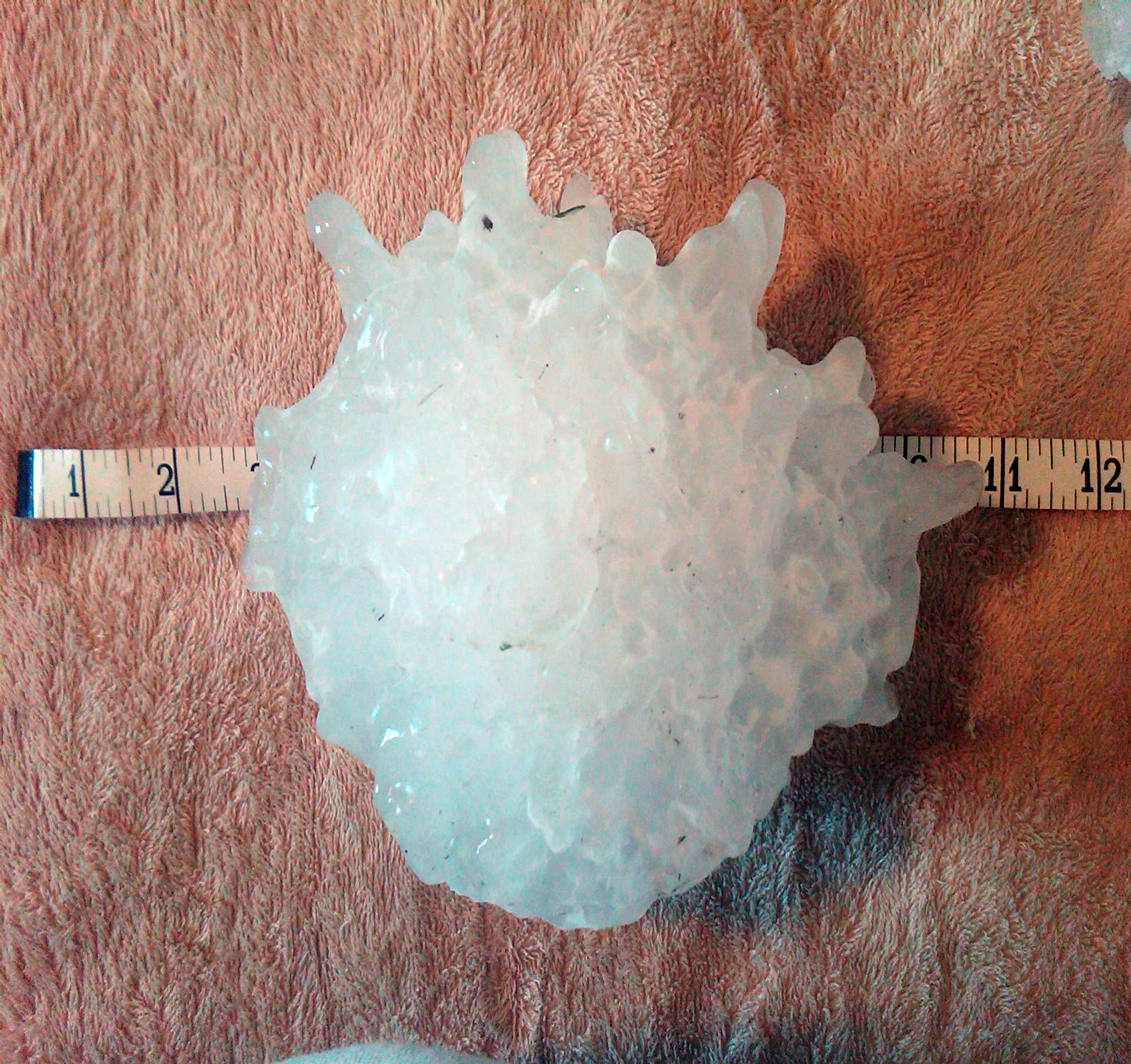
Credit: NWS Aberdeen, SD, public domain, via Wikimedia Commons
Hail is created when rain starts falling up.
This usually happens in the spring, in middle latitudes, when tall clouds form over warm updrafts.
In the cold upper reaches of the cloud, water condenses around nuclei, like dust particles, dirt, or salt crystals, to form droplets of rain that begin to fall to Earth...but then are pushed back upwards by the updraft.
The rain droplets tumble within the cold center of the cloud, falling down and being pushed back up repeatedly, where they collide with other droplets and begin to freeze, turning into tiny hailstones.
More water droplets and water vapor freeze around them, and the hail grows in size and weight.
If the updraft is strong, the hail will continue to be suspended in the middle of the cloud, growing until it’s too heavy to stay aloft. When the hailstones do fall, they can be destructive.
Small hail weighs less than an ounce. But even that can cause billions of dollars in damage, pummeling crops, denting cars, and destroying roofs.
However, hail as large as a softball has been reported, falling at more than 100 miles an hour. Giant hailstones like this have occasionally even killed people.
So, if you see hail larger than golf balls falling, take shelter underground, or inside a building away from windows, which can break.
Because, while a little water never hurt anyone, it can be dangerous as hail.
Background
Synopsis: Hail forms in thunderstorms with strong updrafts that rapidly loft water droplets upward into extreme cold. Larger supercells with intense updrafts may eventually drop large hailstones at high speed that can create billions of dollars in damages and even cause fatalities.
- Hail is frozen water that forms when thunderstorm updrafts repeatedly force droplets into extremely cold parts of the atmosphere.
- Hail typically occurs in midlatitude continental interiors or in mountainous regions of the tropics.
- Unlike sleet or snow, hail doesn’t fall when surface temperatures are cold.
- Hailstorms can occur in any month but are most common in the spring, when warm and cold air masses clash and freezing level in the atmosphere still occurs at the lower altitudes found in winter. Some areas can also see an autumn hail season as the atmosphere cools after summer.
- Cumulonimbus clouds result from atmospheric instability and may grow vertically, developing intense updrafts that carry water droplets above atmospheric freezing level.
- All hailstones start as tiny, supercooled drops of water primed to condense on nuclei like particles of dust, dirt or salt crystals circulating in the storm cloud. Supercooled means the water is still liquid but at temperatures below freezing (32°F or 0°C).
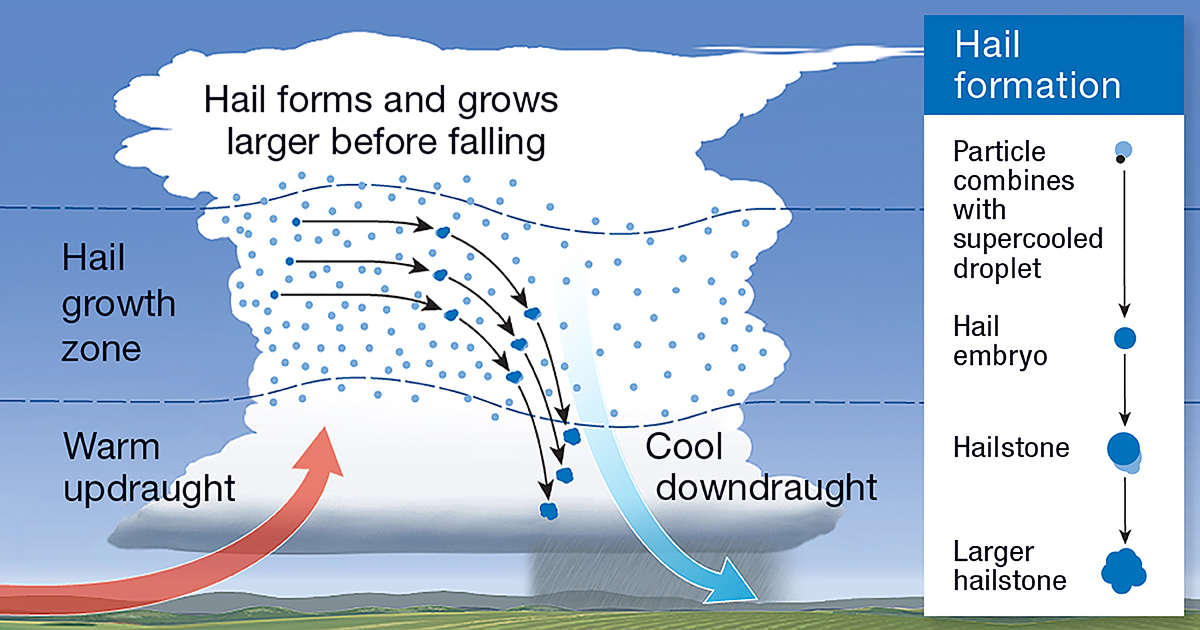
Strong updrafts create a rain-free "vault" underneath the leading edge of a supercell. The lower dashed line indicates the base of the hail growth zone, where the atmosphere is below freezing temperature. Freezing level is at low altitude in winter, rising in spring to a summer altitude, and dropping again in autumn toward the winter level.
Credit: Australian Bureau of Meteorology - Updrafts counter the pull of gravity to keep the tiny hail embryos aloft where they grow by colliding with more supercooled water droplets in the hail growth zone, where temperatures within the updrafts are 14°F to -13°F (-10°C to -25°C). Without the updrafts, the hail would melt as it fell to Earth as rain.
- Supercell thunderstorms prone to hail development typically create a rain-free area where strong updrafts carry rain and hail upward, tumbling hail nuclei repeatedly for up to 30 minutes as they grow in size.
- All hailstones start as tiny, supercooled drops of water primed to condense on nuclei like particles of dust, dirt or salt crystals circulating in the storm cloud. Supercooled means the water is still liquid but at temperatures below freezing (32°F or 0°C).
- As hailstones careen around above freezing level in the cloud, they become layered like onions with transparent and translucent bands.
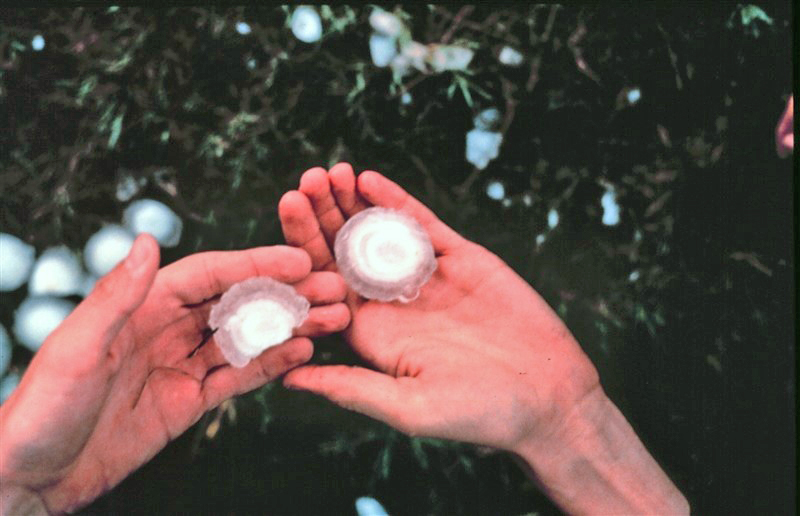
Large hailstone showing both cloudy and clear banding. Cloudy layers froze faster with air bubbles entrained, while clear layers froze slower so that air could escape before they became solid.
Credit: NOAA- Transparent or “wet growth” occurs where it is warmer, so that water doesn’t immediately freeze, allowing air bubbles to escape as water coats the hail nucleus before freezing, producing clear layers.
- Translucent “dry growth” occurs if the air is well below freezing so water droplets freeze immediately upon collision, with air remaining frozen in place as bubbles, producing cloudy layers.
- Layer thickness depends on the speed of the hailstone movement through the conditions; thicker layers indicate longer exposure.
- Hailstones may clump together while moving through warmer portions of a cloud.
- Once hailstones grow to the point that updrafts can no longer support them, or once the velocity of the updrafts abates, the icy precipitation falls to Earth.
- Hail falls in paths called hail swaths that range from acres to many square miles.
- Smaller hail can be blown by surface winds so may occur farther from the central storm, often in icy drifts, but large hailstones tend to fall vertically beneath the storm because of their weight.
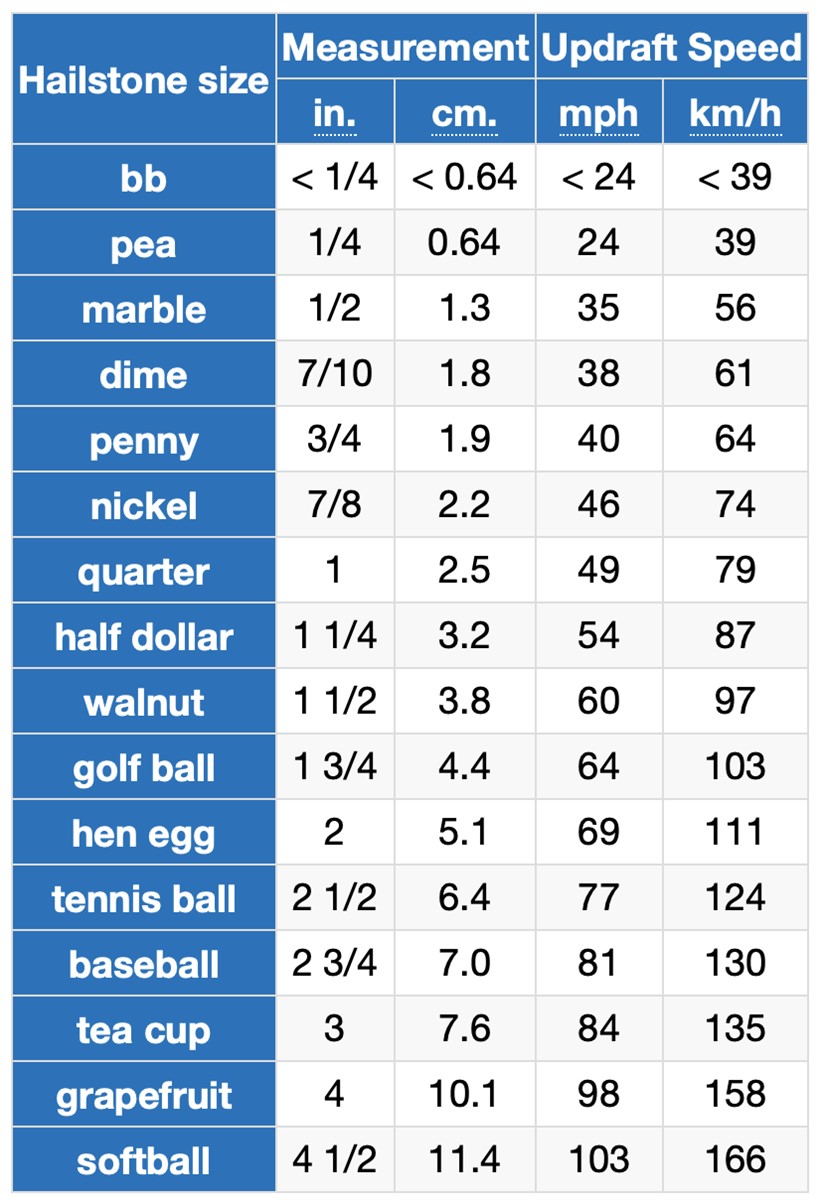
Velocity of updraft wind required to keep various sizes of hail aloft. This is different from the speed at which hailstones tumble to Earth.
Credit: NWS
- Smaller hail can be blown by surface winds so may occur farther from the central storm, often in icy drifts, but large hailstones tend to fall vertically beneath the storm because of their weight.
- To forecast hail, meteorologists look for atmospheric instability and deep moist convection with sustained updrafts strong enough to keep hailstones aloft and freezing levels low enough to create supercooling conditions.
- Hail embryos need condensation nuclei like dust or ice crystals to begin growth.
- Most thunderstorms probably produce hail high up within the cloud, but much of it melts into rain before it can reach the ground.
- Dual polarization radar algorithms are used to sort through results from 10 types of radar echoes to distinguish between large raindrops and hail. Results are refined using eyewitness accounts of hail events and damage caused by hail.
- Hail can damage crops, infrastructure, structures, aircraft and cars and can be deadly to people and animals.
- Most hailstones in the United States range from quarter to golf ball sized 1 to 1.75 in (2.5–4.4 cm).
- The National Weather Service considers hail severe at 1 in (2.5 cm, large and quarter sized), and as diameters increase, hail becomes exponentially more dangerous to property, crops and structures with damages ranging into the billions.
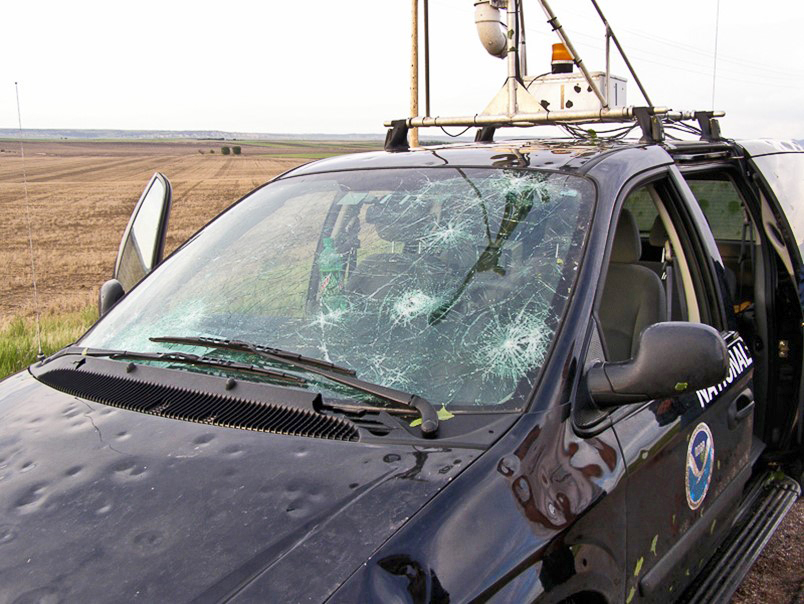
A NOAA vehicle shows damage from multiple large hailstone impacts.
Credit: NOAA - For your own safety, when hailstone size approaches golf ball size (1.75 in or 4.4 cm), take cover underground or in a sturdy building away from windows. These large hailstones can break windows in a building or car and create large dents that may total a vehicle from an insurance perspective.
- The last known fatality occurred in March of 2000 in Lake Worth, Texas, when a 19-year-old man died from head injuries after being hit by a softball sized hailstone.
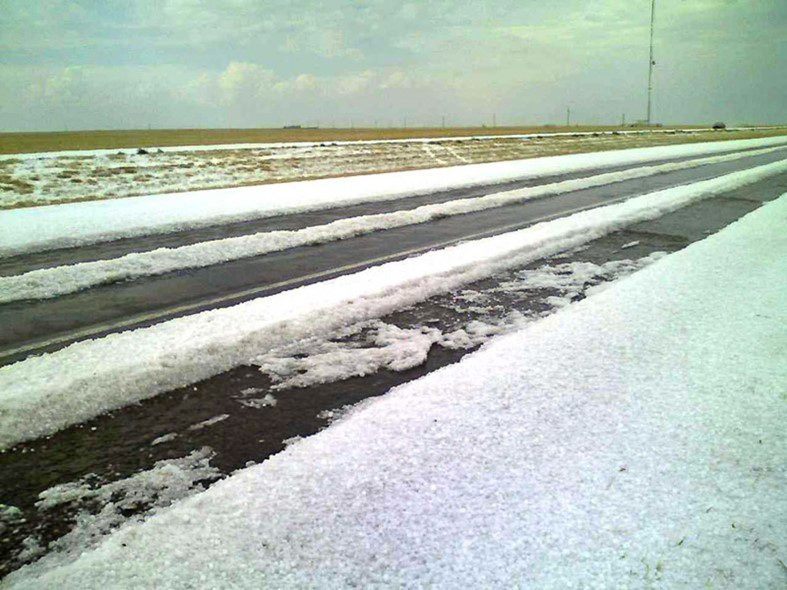
Hail may produce unexpected springtime icy driving conditions if it collects along a roadway.
Credit: NOAA
- Researchers and insurance companies have investigated ways to impact the size of hailstones that reach the ground but haven’t come up with many options.
- Companies can fire flares of silver iodide, which has a crystal structure similar to ice, into supercells to provide additional condensation nuclei that help to reduce the overall size of hailstones by producing more small hailstones.
- It is easy to imagine how that might backfire, though.

